I apologize that this post is less about garden more about bees and it definitely carries a warning as it is not for the faint hearted.
During the past few days our precious honey bees have been attacked by asian hornets – frelons asiatiques. I noticed it first when I saw a huge agitation around the hives.

Amelia stood guard yesterday and the day before with a butterfly net and on each occasions trapped and destroyed four or five asian hornets, some were trying to enter the hive. Altogether she must have caught a dozen hornets over the past few days. It is worth mentioning that despite their size, the asian hornet is not particularly aggressive towards humans and mainly is interested in catching bees near the hive, cutting their head and taking the body to feed their larvae. Sometimes they enter the hive and take bee larvae for the same purpose. A full colony of asian hornets in season can considerably weaken and even destroy a bee hive.
Normally the asian hornets are a problem in this region during August. But yesterday I was working along what we have named our forest walk next to the river Seudre. I noticed a couple of asian hornets landing on the steps I had created. The steps are made from hollow breeze blocks.
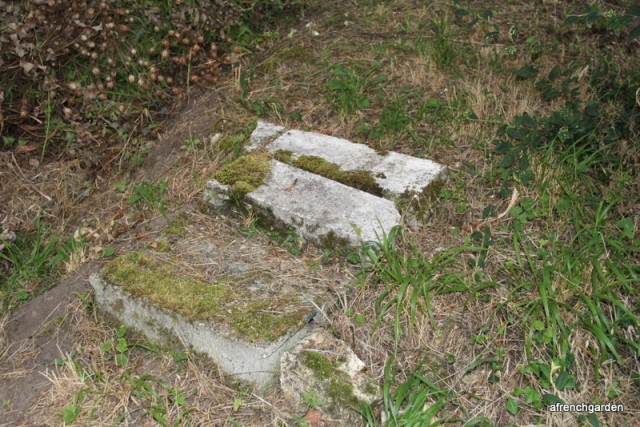
There was no mistake that they were Asian hornets entering and leaving an underground cavity.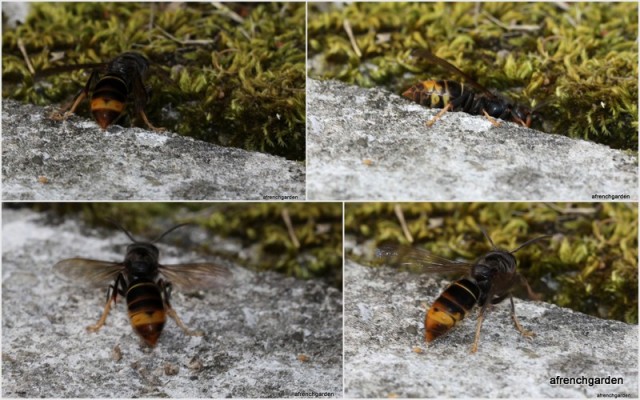
Asian hornet going into underground nest
Searching the internet there is a considerable amount of information on the asian hornets in France and their nests in trees. I found no information on any underground nest. However, what I am beginning to believe is that the hornets do make a small nest underground at the beginning of summer where new hornets are raised, presumably as future queens. Later each can develop a new larger colony in trees. Britain has been so far spared by this new menace to bees, as was France before 2004. The asian hornets are moving north and there might not be too long before they also enter Britain.
Operation destruction had to be put in place when night fell and hopefully all the hornets had returned to the nest. This consisted of first placing straw and sticks on the site and setting fire to it.
Kitted in my bee suit and armed with the propane burner used normally for destroying weeds, I went into battle.
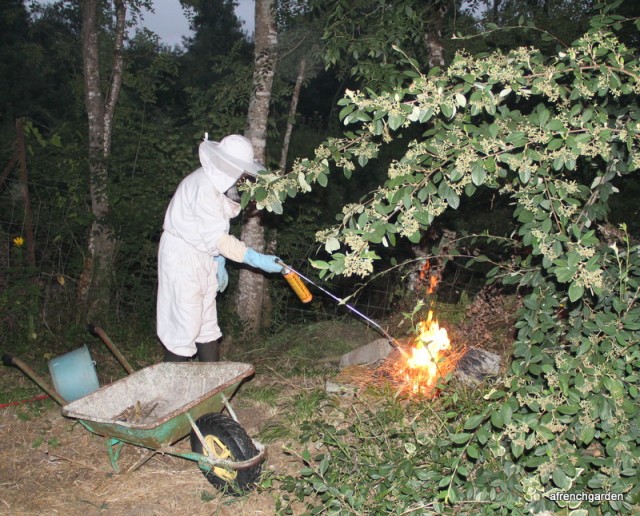
Then we turned the stepping stones over to find the nest and then placed more straw on it and in the hope of burning the area where they nested.

The hornets caring for the larvae were there but already overcome by the smoke and heat of the fire.

The night had fallen and it was already ten o’clock, but my next move was to install hornet guards at the entrance of each of the hives, whilst the hives were quiet. The guards were there, but they were quite gentle.
This morning I went to check that the hornet guards were not too much hindering the bees leaving and entering the hives with pollen.
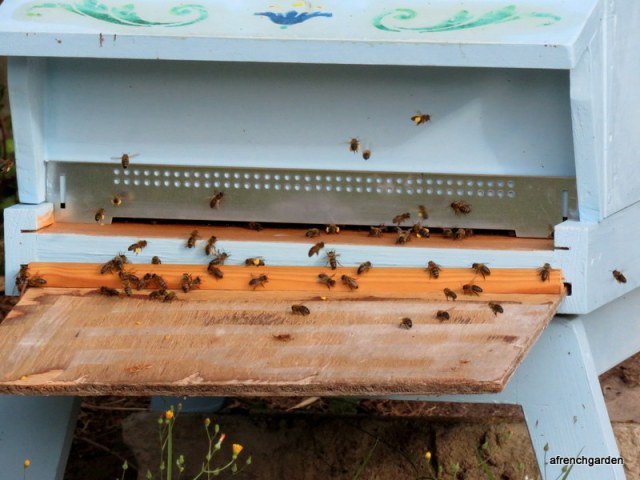
All appeared well and I could see lots of yellow pollen brought in from the fields of sunflower across the road.
I checked and removed the partially burnt out hornet nest and saw the clear papery nest with its pointed back where it was attached to the breeze block.
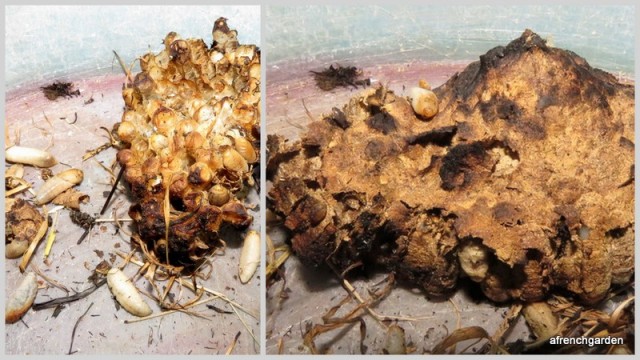
The steps to our forest walk has to be rebuilt.
But should I use breeze blocks again? That is a question that requires some thought. Meanwhile, I am hoping that our bees have been given some respite from the asian hornets.
– Kourosh

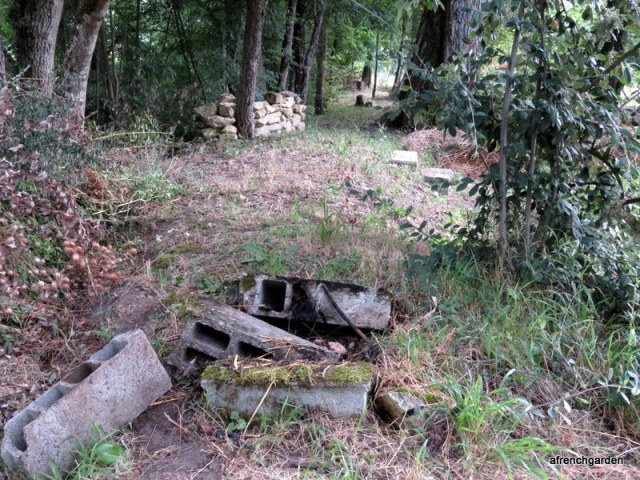
A friend of mine has also had Asian hornets nesting in hollow cement blocks in her garden, so it certainly does happen. Way to go with the flame thrower 🙂
LikeLike
Mine was certainly not a scientific discovery, but I do believe the fact that there seems to be so little published on their colony development in early stages, more systematic research and data gathering needs to be done . Most of us in France have only noticed their nest in August in trees but by then they can be already a sizeable colony and difficult to exterminate without heavy equipment. – Kourosh
LikeLike
Poor bees being molested by these creatures. I’m desperately hoping they don’t reach us across the channel.
LikeLike
We all hope that they will not reach the UK soil. However. one should be on guard. I am not sure if you already use a similar device at the entrance of your hives in the UK. The metallic guard protects the hive not only against predators such as the asian hornet, but also stops mice, etc. entering the hive, as they do so in search of honey _ kourosh
LikeLike
A most interesting story. I think you made a smart decision to use the flame thrower instead of chemicals.
LikeLike
Thanks for the encouragement. I certainly could not have done it easily without Amelia’s help (who was also taking the photos!! – Kourosh
LikeLike
Brave and necessary. Well done!
LikeLike
Thank you. It was not particularly brave as it had to be done. I do not generally like to meddle with nature. But I am rather fond of my bees and I am there to protect them as much as I can. – Kourosh
LikeLiked by 1 person
I agree with Emily, I hope they don’t cross the channel. How much damage are they doing to beehives in France?
LikeLike
Thank you, Philip for the comment. The bee keepers in France are certainly on their guard against this predator and each year place traps around the gardens and near their hives to trap them. I am not so sure if that is very effective, as they also trap many other insects including bumble bees and moths.
You see, although asian hornet has become a menace in France only since 2005, and they do considerable damage to bee hives, they are not the main enemy of honey bees: mankind is their biggest enemy; over-treating the crops with deadly chemicals such as néonicotinoïdes manufactured by Bayer. The EU has issued “directives” to countries such as France to ban its use, but it will not be put in force until 2017 – or, I suppose, until the current stock is used up! Kourosh
LikeLike
Glad you were quickly able to locate the hornets’ nest.
LikeLike
Thanks. We were so glad. Today the bees appeared much calmer going about their “beesiness”. – Kourosh
LikeLiked by 1 person
It’s probably good that you got right after them. I hope this is the end of your Asian hornet woes.
LikeLike
I do hope that this might have put an end to a number of hornet colonies, but we do have to remain on guard. – Kourosh
LikeLiked by 1 person
Oh no…another thing to worry about for our bees!
LikeLike
I also hope that they will not go beyond these shores. Nevertheless, one should rest vigilant and protect our bees against all harm. – Kourosh
LikeLike
Oh my goodness I had no idea. I think you were rather brave attacking the hornet nest especially as you now have to rebuild your steps. Good luck bees
LikeLike
Thank You. I have a sticker on my car from RSPB saying “we give nature a home”. But I sometimes wish that some parts of nature would make their home elsewhere. Rebuilding the steps is a very small price to pay for helping my bees against this predator – Kourosh.
LikeLike
You’re lucky you saw them and were able to find the nests. I think I’d use something else for the steps. The cavities in the blocks seem to be a perfect nesting spot.
LikeLike
Thank you. I am glad that someone else also thinks that the blocks are not such a good idea. Luckily, I have loads of large stones at the end of the garden that I can try to use as steps. Once the temperature drops a bit (now is it around 34 C during the days), I can work on that project. – Kourosh
LikeLike
How brave, these hornets sound terrifying for humans as well as bees. I say that after being stung by an ordinary hornet ,Vespa cabro here. A hornet sting packs quite a punch, I imagine one from one of these big fellows would be even more painful.
LikeLike
Thanks for the comment. I am very sorry that you were stung by a hornet. I have great sympathy, as I was also stung when I was around ten years old and a good few decades later the marks are still visible. However, it is worth noting that the European hornet Vespa crabro, (frelon européen) is actually larger than the asian hornet, Vespa velutina (frelon asiatique). And, the asian variety is not normally aggressive towards humans, unless threatened. The pain – although I hope neither of us are ever subjected to – is about the same for both species.
LikeLike
That was fascinating to learn. I hope all of the asian hornets were destroyed! I admire people who have bees as it is something I’d love to do, but am slightly fearful of!
LikeLike
Bees are indeed fascinating creatures and we have much to learn from their behaviour. I suppose the fact that all of the bees in a colony (up to fifty thousands or even more) are actually half sisters, has something to do with it. I was also apprehensive, but it is a great hobby and you might wish sharing it with a friend. There are bee keepers who jointly buy and keep bee hives. That reduces the expense and the work, whilst increasing the joy of sharing. I am glad that Amelia shares my interest. Buckfast bees and many mixed races, tend to be quite gentle. Good luck.
LikeLike
Well done. It’s horrible to have to kill any animals but in this case I see your back was against the wall. The method you used seems to have been very effective and only destroyed the guilty colonies where poisons would have a much broader effect.
That photo with so many girls loaded with pollen is amazing. I expect your queen is hard at work in there building up numbers to fight off the invading wasps!
LikeLike
Nice to hear from you, Laura.
I do not like meddling too much with nature’s mysterious ways. However, like you, I do see it as my duty to protect my bees. I agree about chemical methods that can be harmful to many other creatures.
The fascinating thing about pollens is that Amelia has photographed the frames whilst we inspected the hives, and there are cells filled with yellow pollen (at this time from sunflowers), also black pollen (from poppies), beige pollen (from sweet chestnuts and other plants), and even a very pretty mauve pollen (trying to find out where that came from?). I watch them first in the mornings when they bring in mainly pollen. Later in the day it is mostly nectar. This morning dozens were strpping all the pollen from the gaura flowers! – Kourosh
LikeLike
That hornet screen looks pretty tight. Can drones (and queens) fit through? I’ve never seen such a thing here.
I’m assuming we don’t have a problem with Asian hornets in Australia since I’ve never heard anyone complaining about them but it never hurts to be informed just in case.
LikeLike
The hornet screen is adjustable by two screws at the sides. However, the lower limit is carefully calculated allowing the bees – at this time very few drones – come and go. As for the queen, I do hope that she does not leave us!! My friend, Michel, the bee keeper had told me that the asian hornets are mainly a problem in August. Up to a few days ago I had removed the screens completely to allow full access of thousands of bees to go in and out. I have just placed the screens and they have no problem getting in with their parcels.
Unfortunately even after destroying the nest, Amelia and I have killed quite a few more hornets (both European and Asian, equally harmful to bees)
As far as I know you do not have the problem with theses hornets – as yet. There were also no asian hornets here in France until 2005. Now they are moving each year northwards. They have not yet entered the UK, but the British bee keepers are worried and on the look out.
One last thing, the screens are also useful in winter as they stop rodents entering and rubbing honey. The little holes above the entrance is for ventilation. The screens here are only 1 euro 20 cents. Good insurance policy. – Kourosh
LikeLike
I hope as well that your queen doesn’t leave, but if the colony creates queen cells and a new queen hatches, she’ll have to or fight to the death. I think leaving is the least terrible of the 2 options.
I was afraid it wouldn’t be so simple as to destroy one hornets nest. In a way it’s reassuring to know some insects are thriving, it’s just a shame they have to have a taste for honey bees!
We partially close our entrances in winter as well – or we do sometimes on some hives (we’re rather erratic I’m afraid). We put a piece of wood (an old wooden slatted blind) across the entrance leaving only about 2 inches worth of entrance open. This hopefully helps with temp control and also makes life easier on the guard bees to watch a smaller attack point. We also put linoleum under the lid to help limit heat loss in winter. Our hive boxes aren’t as well insulated as those used in colder climates so when it does dip below freezing our girls have to work extra hard. Luckily that’s not often or for long.
LikeLiked by 1 person
Firstly I agree with you that nature’s way of bees swarming is perhaps the kindest way. Here they put the hornet guard only for two to three months. and certainly it is removed by early in the new year and throughout the Spring. Our first swarm was probably an old queen who left her previous palace with about half her colony. The second and the third swarms we captured were most likely new queens. You are right, often mother nature knows the best way of sorting things out.
The insulation we use here is specially made and is either thin aluminium sandwiched with some kind of insulating material in the middle, or sheets of wood fibre about half inch thick. I use both although I prefer the latter as it also absorbs some moisture. Here it does not get too cold in winters with hardly ever a snow, but we are in a maritime region and so humidity can bother the bees more than the cold. – Kourosh
LikeLike
I just looked up the thickness of our hive walls. They are 22mm thick. That’s it, that’s all that stands between our colonies and the outside environment. We try to put a frame of capped honey on the outside of the brood boxes in autumn to help insulate but otherwise it’s up to the bees. My husband has commented how much thicker European (at least German) bee hives are to help insulate the hives in winter.
When you talk about using insulation, do you mean what your hives are made of or do you change/add parts in autumn?
LikeLike
Hopefully that is the only nest in your area. So far they haven’t reached us in southern England but I fear it is only a matter of time.
LikeLiked by 1 person
Thank you, Marie. Sadly even after the destruction of that nest we have caught at least twenty more asian as well as European hornets attacking the hives – four or five each day. I hate watching them carrying off our bees one by one. But at the end, I suppose one has to accept nature’s way.
You are correct; the bee keepers in the UK are quite rightly concerned if and when these hornets arrive in the UK. – Kourosh
LikeLike